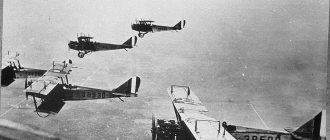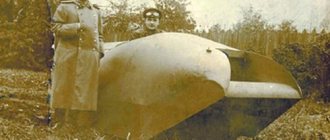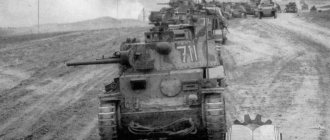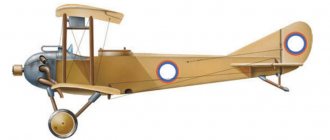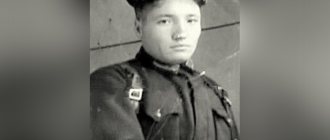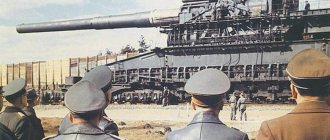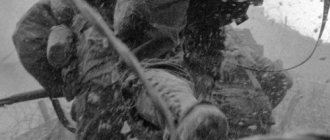The development of airspace is a relatively new stage in the development of industry, which began at the end of the 19th century. The term “aviation” itself is translated as “bird”. For the first time, humanity learned the strength and power of iron hawks with the advent of one of the most destructive and cruel events in history - World War I. The aircraft of these times did not have good technical parameters, but gave rise to the emergence of high-quality and useful devices, both for air battles and for passenger flights.
The appearance of the first military aircraft
You may be interested in:What is an abstract: introduction, outline, footnotes
Airplanes of World War I began to appear during the beginnings of the conflict. Initially, these were bulky and clumsy “flying tanks” capable of transporting personnel. They were not equipped with assault machine guns or bomb compartments. The main firepower of World War I aircraft was provided by personnel weapons.
As military craft developed, by 1915, fighter aircraft began to appear. They reached speeds of up to 150 km/h and could cause serious damage to infantry and tanks. They used weapons of varying effectiveness, including machine guns, steel weights and grenades.
Bombers exemplified the military superiority of German aircraft during World War I. At that time, these were the most destructive, large-sized and impenetrable vehicles. With the advent of these means, sirens began to appear in many European cities, notifying the local population of the approach of bombing attacks.
Aviation 1914 - revolvers and carbines
Yes, as already mentioned, the pilot’s revolver was sometimes the only offensive and defensive means of aviation in the first year of the World War. Naturally, mustachioed pilots in white scarves firing at each other from a revolver is very beautiful, but completely ineffective. The main “heavy” armament of aircraft of that period was an ordinary shortened carbine - it could easily be used by an observer or a second crew member, but with almost the same effectiveness as a revolver. The temptation to grab a machine gun instead of a carbine was great, but a bulky and heavy mechanism in a cramped aircraft cabin with a weak engine would be more of a stone around the neck than a real help in battle.
With bombs, things were simpler - it was quite easy to adapt ordinary artillery shells of small calibers, equipped with stabilizers, for them. However, the British RNAS already in 1914 acquired Hall bombs of caliber from 10 to 56 kg, i.e. in fact, the first "factory" aerial bombs.
This is not a bomb, this is a so-called "flechette" - a small steel arrow or dart
If it was initially assumed that bombs were loaded into the pilot's cabin and dropped manually (the fuse was first removed from them), then in the fall of the same 1914, the British and French began to hang them under the fuselage and wing. The discharge was carried out mechanically.
...if you don’t know that a flechette dropped even from a hundred-meter height will pierce through a piece of wood 30 cm thick. a real shower of death fell on the infantry columns passing below
Airplanes of Germany
You may be interested in: Height 611: facts about the UFO crash, scientific explanation, photo of the crash site
The military forces of the Central Powers at the time of the First World War were far ahead of many European states. Despite the obvious weakness of the Allies, Germany was the second power in the number of aircraft in the world. It had 240 Taube units and was a serious competitor to the Entente. The First World War gave impetus to the development of the aircraft manufacturing industry and secured the sad glory of German bombers, which destroyed everything in their path.
Thanks to the rapid development, the troops of the Central States were able to strengthen their dominant position in the air almost until the very end of World War I. German aircraft were the first to be used to bomb enemy strategic targets. The most famous aircraft were the light triplanes Foker and Taub. They were lightweight structures capable of conducting fast and effective battles.
German airships as part of the Air Force
In addition to bombing from the usual aircraft today, Germany also used airships in its bombing. During the 4 years of the war, the Germans built more than 100 Zeppelins and Schutte-Lants. Unlike civilian airships, military vehicles were provided with powerful protection against all types of known weapons.
Such aviation was ideal for ensuring the protection of naval approaches to the borders of occupied territories and bombing strategic targets located on the line of contact.
German Allied aircraft
As you know, one of the main reasons for the defeat of the troops of the German Empire was the low preparedness of the Allied troops. Austria-Hungary and the Ottoman Empire were extremely poorly qualified in the field of aviation. Excessive conservatism cost them defeat in the war.
If we talk about specific numbers, then Austria-Hungary had only 30 aircraft in service, including the O and the Foker. Only towards the end of the war did the Allies begin mass production of fighters.
The Ottoman Empire did not have air-military forces at all. At the outbreak of World War I, the aircraft were ordinary airplanes for passenger cargo transportation. Germany assisted in ensuring the air superiority of the Ottoman Empire by supplying the most modern models such as the Palatinate, Rampler and Taub. These were the most popular and popular models of the early 20th century, which had low resistance to enemy attacks.
Russian Imperial Air Force
Despite Russia's strong lag behind the rest of the world, in terms of military power it had practically no equal, except for the French and German troops. The same applies to the air force. The names of the World War I aircraft that took part in clashes on the part of the Russian Empire remained well known for many years.
At the time of 1914, Russia had more than 260 aircraft in service, which exceeded all countries participating in the conflict. And this despite the fact that the air fleet had not yet been fully formed. The main striking force of the empire was the first multi-engine Ilya Muromets - the most advanced and powerful bombers.
In addition to the latest developments, Russia also used older models, which were significantly inferior not only to new products, but also to the developments of German engineers. Today such planes are called “Corn Ruckers”. They were made from the most ordinary wooden plywood, and therefore were extremely vulnerable against any type of weapon, be it machine guns or pistols. Basically, such means were used during night flights and reconnaissance operations.
The Russian Empire became the first country in the world to use aircraft carriers in its arsenal. In total, there were 5 ships in service capable of carrying aircraft.
Tactics of air combat in the First World War
At the beginning of the war, when planes collided, the battle was fought with personal weapons or using a ram. The ram was first used on September 8, 1914 by the Russian ace Nesterov. Both planes fell to the ground. On March 18, 1915, another pilot used a ram without crashing the plane and returned to base. This tactic was used due to the lack of weapons or their low effectiveness. The ramming of the pilot required exceptional accuracy and composure, so the rams of Nesterov and Kazakov were the only ones in the history of the war.
At the later stages of the war, pilots tried to go around the enemy plane from the side, and, going into the tail, shoot with a machine gun. This tactic was used in group battles, and the pilot who took the initiative and forced the enemy to fly away usually won. The style of air combat with active maneuvers and shooting from a short distance was called “dogfight” and until the 1930s dominated ideas about air warfare.
A special element of air combat was attacks on airships. The airships had defensive weapons in the form of machine guns, were not inferior to airplanes in speed at the beginning of the war, and were significantly superior in their rate of climb. Before the advent of incendiary bullets, machine guns had little effect on the hull of airships, and the only way to knock out an airship was to fly over it and drop hand grenades on the keel of the ship. Several airships were shot down, but in general, the airships usually emerged victorious in encounters with airplanes.
This changed with the advent of incendiary bullets in 1915. Incendiary bullets allowed the escaping hydrogen to ignite, causing the destruction of the airship.
Royal Flying Corps
The British Empire became one of the first countries to develop aircraft for military purposes. Photos of aircraft from World War I that fought on the side of Great Britain can be seen in many well-known publications that appeared after 1918.
Despite the high level of personnel training, British aircraft were slightly inferior to German and French aircraft. The first British fighter aircraft equipped with a high-precision machine gun was the Vickers aircraft. Its development began in 1912, and by the beginning of World War I, 60 copies had been produced. During the war, more than 3.3 thousand airplanes were also created, which made the British Air Force the most numerous troops in post-war Europe.
The scope of use of combat vehicles was very different, ranging from patrolling the vicinity of the contact line, ending with aerial bombardment and reconnaissance operations. With the help of aircraft, British intelligence officers were dropped behind enemy lines, which played an important role during the war.
"Avro-504" 1913. The English designer Elliott Verdon Roe created in 1910 and after three years of experiments prepared a new two-seater training aircraft "Avro-504" for mass production. The car turned out to be very successful. The initial order for the War Ministry and the Admiralty was soon increased, and by August 1914 there were already 63 aircraft in the Royal Flight Corps and Royal Navy Air Service divisions. In total, from 1913 to 1933, about 10 thousand aircraft of all modifications were built all over the world, including 8,340 aircraft in Great Britain, and about 800 aircraft in the USSR (U-1 and MU-1). The Avro-504 aircraft is a two-seat, two-post biplane of wooden construction with a rather long fuselage. The fuselage has a rectangular section; made of wooden blocks covered with canvas with braces made of steel wire or tape. The canvas was impregnated with aviation varnish. The engine mounting was made of steel pipes and profiles. The engine hood was made of aluminum sheets. The wings are three-spar. The spars were made from bars milled in the shape of an I-beam. The wing was covered with fabric, which was attached to the ribs, stitched and varnished. The biplane box stands are wooden, teardrop-shaped. Guys made of steel cable or tape. Cars of later modifications had a two-spar wing with more powerful spars. The upper and lower wings were equipped with ailerons. The rudder is small in size without a keel. The elevators and stabilizer are of a conventional design. The stabilizer was additionally secured with struts. Chassis with rubber shock absorption and anti-crash ash timber. The aircraft was equipped with 7- and 9-cylinder air-cooled engines, rotary, star-shaped, different for different modifications. The propeller is wooden, two-bladed. The aircraft is controlled by cable, from the control stick and pedals, and in training machines both cockpits were equipped with a control system. On RFC and RNAS light bombers, the rear cockpit was equipped with a pivot-mounted Lewis machine gun. Bombs with a total mass of 37 kg were suspended under the wing. Based on the land variants of the Avro-504, float variants were produced. The floats had a complex design; they were made of thin (4 mm) ash boards in two layers, mounted on a frame of ash beams. Between the layers of boards, a canvas impregnated with non-hardening varnish was laid. The entire structure was fastened with copper rivets on aluminum washers and brass screws. The float stands are steel pipes with wooden fairings. The construction was very labor-intensive and quite heavy. In the USSR, in the early 1920s, the design of floats was significantly simplified. They were made above the waterline from 4-5 mm plywood, which reduced their weight from 211 kg to 170 kg without compromising their strength, and also significantly reduced the cost of production.
Modifications
Avro-504 is a prototype with a Gnome engine (80 hp), a two-seater training aircraft. Several cars were produced for flying clubs. Avro-504B is a serial training aircraft with the same engine for RFC and RNAS. Minor changes in design. "Avro-504C" - a reconnaissance aircraft based on the previous one, with the same engine, the pilot was located in the rear cockpit, the observer in the front. "Avro-504E" is a further development of the "C" series. It was distinguished by the placement of the pilot and observer, as well as additional reinforcement of the fuselage frame. Engine “Gnome-Monosupap” (100 hp). "Avro-504G" is a further development of machines of this series; the fuselage is reinforced with longitudinal bars. The wing became two-spar, its profile changed. The design of the hood has changed. Avro-504H is an aircraft equipped for launch from a catapult. "Avro-504J" is a training aircraft for the RAF with a Gnome-Monosupap engine (100 hp). Both cabins are equipped with a control system. 2267 vehicles of this modification were built. "Avro-504K" is a mass series. Light bomber and reconnaissance aircraft, training aircraft. Engines were installed: “Gnome-Monosupap” (100 hp), “Ron” (110 and 120 hp), “Clerge” (130 hp). Sometimes used as a fighter. "Avro-504L" is a float version of the "Avro-504K" aircraft, flight data is worse than that of a land aircraft. U-1 is an initial training aircraft, built in the USSR from 1921 to 1932 on the model of the English Avro-504K. It differed in construction materials (pine instead of ash and mahogany, steel instead of copper sheet) and manufacturing technology. Engine M-2 (120 hp). When testing for strength, tests showed that the machine complies with modern requirements. MU-1 is a float version of the U-1 aircraft for naval aviation. Flight performance is not bad. However, the turn and climb times were twice as long as the prototype.
The U-1 and MU-1 aircraft were produced first at plant No. 5, and since 1923 at. In England, decommissioned aircraft were converted into training ones for both military flight schools and flying clubs. Some vehicles were in use until 1933. In the USSR, U-1 aircraft were operated until 1935, until they were replaced by N. N. Polikarpov’s U-2 aircraft.
FLIGHT PERFORMANCE
Avro-504 Avro-504E Avro-504G Avro-504K Avro-504L U-1 MU-1 prototype 1914 1915 1923 1925 1913 Spread, m 10.97 10.98 10.98 10.98 10.98 10.85 10.85 Length, m 8.91 8.98 8.98 8.98 9.85 8.78 9.85 Height, m 3.15 3.18 3.18 3.18 3, 3.18 3.58 Wing area, sq.m 31.77 30.70 30.66 30.70 30.70 30.0 30.0 Dry weight , kg 450 558 499 588 800 600 840 Take-off weight, kg 703 828 816 828 1040 840 1080 Engine: “Gnome” “Gnome-“Ron” “Ron” M-2 Monosupap” power, l. With. 80 100 120 110 120 Maximum speed, km/h 132 140 132 145 132 137 136 Flight range, km 400 300 420 400 195 190 Ceiling, m 3650 3960 4880 3500 4500 3200 Crew, people 2 2 2 2 2 2 2 Armament - 1 machine gun 1-2 machine guns - - - 37 kg bombs 37 kg bombs
French aviation
It is rightfully considered the most powerful striking force of the period 1914-1918. If we talk about what kind of aircraft were in France during World War I, it is extremely difficult to underestimate them. It is on the basis of these developments that world aviation is still developing today.
The main difference from developers in other countries is that when creating projects, not only the most advanced engineers, but also the pilots themselves participated. Thanks to such cooperation, the “storm of the sky” was born - Moran Sayulnir-M, which became the best fighter presented at the beginning of the war. During its development, pilots' assessments were taken into account, the most vulnerable parts of the aircraft were strengthened, and it became possible to fire a machine gun through the propeller.
Reconnaissance aircraft deserve special attention. The Blériot 11 also became the best reconnaissance aircraft. If you look at an archival photo of World War I aircraft, you can note the exceptional innovation of French aircraft.
Italian Air Force
If we talk about the pace of aviation development, Italy has become the fastest growing power in this field. Despite varying success in terms of domination in the sky, the Italians were able to move to a fundamentally new level. If at the beginning of the war Italy did not even have its own aircraft, then a year later the best heavy bombers, Caproni K-1 and Caproni K-2, were produced. The prototypes were so successful that they were able to pass tests at sites unprepared for such actions. These were extremely strong and heavy vehicles, capable of flying up to several thousand kilometers without requiring refueling or technical repairs.
Source
Aviation 1916 - His Majesty Synchronizer
0
The propeller synchronizer was an invention that raised the efficiency of combat aviation to a new level. A simple device that delays the firing of a machine gun at the moment when the propeller blade passes in front of the barrel has revolutionized air warfare. Synchronized machine guns were predominantly equipped with ammunition belts. The development of engines also did not stand still - aircraft became much more powerful and more carrying capacity, which means more bombs and machine guns could be placed on board. At the end of the year, the French surprised again - they managed to install a light automatic 37-mm Hotchkiss cannon on Voisin aircraft!
0
Three hundred kilogram bombs became a reality, as did fighter attacks on bombers and anti-aircraft (“anti-aircraft”) artillery fire. Bombers, fleeing from these misfortunes, began to climb higher and higher into the sky, and this dictated the appearance of another innovation - a bomb sight, which made it possible to take into account the altitude and speed of flight, and wind speed. For the first time they were installed on the same S-22 Ilya Muromets bombers.
